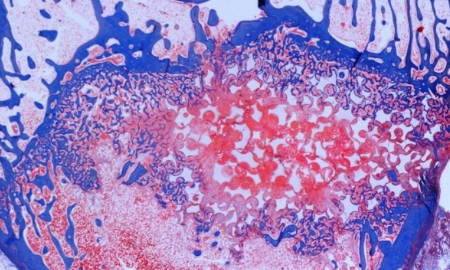Biomaterials for Use as Bone Void Fillers, Bone Grafts, and Synthetic Bone Graft Substitutes
Bone is one of the most frequently transplanted tissue in humans, second only to blood. It is estimated that over 500,000 bone grafts are needed in the United States per year. OREC's Biomaterials & Histology Laboratory investigates the use of calcium phosphates, bone void fillers, and other synthetic bone graft substitutes to avoid many of the problems associated with natural bone grafts.

Image: Histology images showing (left) early bone healing with calcium phosphate granules in a rabbit femoral corticocancellous bone defect model (Masson Trichrome, mm scale in field) and (right) complete incorporation of calcium phosphate granules in the same model at a later time point (H&E, original magnification = 79x).
Selected Publications
Dunkley IR, Vickers SM, Badura JM, Toth JM: A Histological Assessment of the Mechanism of Early-Stage Healing of a Biphasic Calcium Phosphate in an In Vivo Rabbit Model. Key Engineering Materials, 782:275-282, 2018.
Toth JM, Schwartz DG, Mobasser J-P, Williams J: Instrumented Lumbar Corpectomy and Spinal Reconstruction Comparing rhBMP-2/Compression Resistant Matrix (CRM), rhBMP-2/Absorbable Collagen Sponge (ACS)/ Ceramic Granules Mixture, and Autograft In Two Different Devices - A Study In Sheep. SPINE. 41(6): E313-E322, Mar 15, 2016.
View more BIMA Research
Join BIMA
The Biomaterials & Histology Laboratory is looking for individuals with an interest in learning more about biomaterials or participating in collaborative research projects. For more information on becoming a member of BIMA, contact Dr. Toth.



